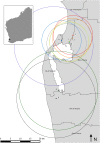Mosquito and Virus Surveillance as a Predictor of Human Ross River Virus Infection in South-West Western Australia: How Useful Is It?
- PMID: 30182918
- PMCID: PMC6159580
- DOI: 10.4269/ajtmh.18-0459
Mosquito and Virus Surveillance as a Predictor of Human Ross River Virus Infection in South-West Western Australia: How Useful Is It?
Abstract
Mosquito and virus surveillance systems are widely used in Western Australia (WA) to support public health efforts to reduce mosquito-borne disease. However, these programs are costly to maintain on a long-term basis. Therefore, we aimed to assess the validity of mosquito numbers and Ross River virus (RRV) isolates from surveillance trap sites as predictors of human RRV cases in south-west WA between 2003 and 2014. Using negative binomial regression modeling, mosquito surveillance was found to be a useful tool for predicting human RRV cases. In eight of the nine traps, when adjusted for season, there was an increased risk of RRV cases associated with elevated mosquito numbers detected 1 month before the onset of human cases for at least one quartile compared with the reference group. The most predictive urban trap sites were located near saltmarsh mosquito habitat, bushland that could sustain macropods and densely populated residential suburbs. This convergence of environments could allow enzootic transmission of RRV to spillover and infect the human population. Close proximity of urban trap sites to each other suggested these sites could be reduced. Ross River virus isolates were infrequent at some trap sites, so ceasing RRV isolation from mosquitoes at these sites or where isolates were not predictive of human cases could be considered. In future, trap sites could be reduced for routine surveillance, allowing other environments to be monitored to broaden the understanding of RRV ecology in the region. A more cost-effective and efficient surveillance program may result from these modifications.
Figures



Similar articles
-
Proximity to mosquito breeding habitat and Ross River virus risk in the Peel region of Western Australia.Vector Borne Zoonotic Dis. 2015 Feb;15(2):141-6. doi: 10.1089/vbz.2014.1693. Vector Borne Zoonotic Dis. 2015. PMID: 25700045 Free PMC article.
-
Analysis and prediction of Ross River virus transmission in New South Wales, Australia.Vector Borne Zoonotic Dis. 2014 Jun;14(6):422-38. doi: 10.1089/vbz.2012.1284. Epub 2014 Apr 18. Vector Borne Zoonotic Dis. 2014. PMID: 24745350
-
Geographic Information Systems used to describe the link between the risk of Ross River virus infection and proximity to the Leschenault estuary, WA.Aust N Z J Public Health. 2012 Jun;36(3):229-35. doi: 10.1111/j.1753-6405.2012.00869.x. Aust N Z J Public Health. 2012. PMID: 22672028
-
Imported cases of Ross River virus disease in New Zealand - a travel medicine perspective.Travel Med Infect Dis. 2012 May;10(3):129-34. doi: 10.1016/j.tmaid.2012.04.001. Epub 2012 May 10. Travel Med Infect Dis. 2012. PMID: 22579017 Review.
-
Ross River virus: ecology and distribution.Annu Rev Entomol. 2002;47:1-31. doi: 10.1146/annurev.ento.47.091201.145100. Annu Rev Entomol. 2002. PMID: 11729067 Review.
Cited by
-
A Multi-Species Simulation of Mosquito Disease Vector Development in Temperate Australian Tidal Wetlands Using Publicly Available Data.Trop Med Infect Dis. 2023 Apr 3;8(4):215. doi: 10.3390/tropicalmed8040215. Trop Med Infect Dis. 2023. PMID: 37104341 Free PMC article.
-
Metatranscriptomic Sequencing of Medically Important Mosquitoes Reveals Extensive Diversity of RNA Viruses and Other Microbial Communities in Western Australia.Pathogens. 2024 Jan 25;13(2):107. doi: 10.3390/pathogens13020107. Pathogens. 2024. PMID: 38392845 Free PMC article.
-
Arthritogenic Alphaviruses: A Worldwide Emerging Threat?Microorganisms. 2019 May 14;7(5):133. doi: 10.3390/microorganisms7050133. Microorganisms. 2019. PMID: 31091828 Free PMC article. Review.
-
Development of a Rapid Surveillance System for Ross River Virus in Mosquitoes Through Reverse-Transcription Loop-Mediated Isothermal Amplification (RT-LAMP).Transbound Emerg Dis. 2025 Feb 28;2025:1772438. doi: 10.1155/tbed/1772438. eCollection 2025. Transbound Emerg Dis. 2025. PMID: 40302734 Free PMC article.
-
Ross River Virus Infection: A Cross-Disciplinary Review with a Veterinary Perspective.Pathogens. 2021 Mar 17;10(3):357. doi: 10.3390/pathogens10030357. Pathogens. 2021. PMID: 33802851 Free PMC article. Review.
References
-
- Knope KE, et al. National Arbovirus and Malaria Advisory Committee , 2016. Arboviral diseases and malaria in Australia, 2013–14: annual report of the National Arbovirus and Malaria Advisory Committee. Commun Dis Intell Q Rep 40: E400–E436. - PubMed
-
- Harley D, Bossingham D, Purdie DM, Pandeya N, Sleigh AC, 2002. Ross River virus disease in tropical Queensland: evolution of rheumatic manifestations in an inception cohort followed for six months. Med J Aust 177: 352–355. - PubMed
-
- Russell RC, 2002. Ross River virus: ecology and distribution. Annu Rev Entomol 47: 1–31. - PubMed
MeSH terms
LinkOut - more resources
Full Text Sources
Other Literature Sources
Medical

